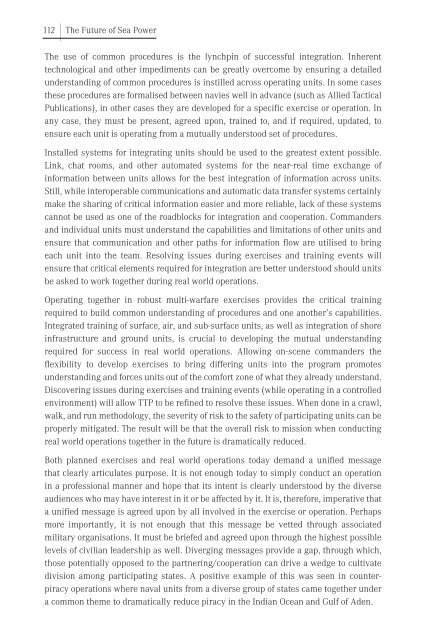THE FUTURE OF SEA POWER
SPC2015_Proceedings
SPC2015_Proceedings
Create successful ePaper yourself
Turn your PDF publications into a flip-book with our unique Google optimized e-Paper software.
112 |<br />
The Future of Sea Power<br />
The use of common procedures is the lynchpin of successful integration. Inherent<br />
technological and other impediments can be greatly overcome by ensuring a detailed<br />
understanding of common procedures is instilled across operating units. In some cases<br />
these procedures are formalised between navies well in advance (such as Allied Tactical<br />
Publications), in other cases they are developed for a specific exercise or operation. In<br />
any case, they must be present, agreed upon, trained to, and if required, updated, to<br />
ensure each unit is operating from a mutually understood set of procedures.<br />
Installed systems for integrating units should be used to the greatest extent possible.<br />
Link, chat rooms, and other automated systems for the near-real time exchange of<br />
information between units allows for the best integration of information across units.<br />
Still, while interoperable communications and automatic data transfer systems certainly<br />
make the sharing of critical information easier and more reliable, lack of these systems<br />
cannot be used as one of the roadblocks for integration and cooperation. Commanders<br />
and individual units must understand the capabilities and limitations of other units and<br />
ensure that communication and other paths for information flow are utilised to bring<br />
each unit into the team. Resolving issues during exercises and training events will<br />
ensure that critical elements required for integration are better understood should units<br />
be asked to work together during real world operations.<br />
Operating together in robust multi-warfare exercises provides the critical training<br />
required to build common understanding of procedures and one another’s capabilities.<br />
Integrated training of surface, air, and sub-surface units, as well as integration of shore<br />
infrastructure and ground units, is crucial to developing the mutual understanding<br />
required for success in real world operations. Allowing on-scene commanders the<br />
flexibility to develop exercises to bring differing units into the program promotes<br />
understanding and forces units out of the comfort zone of what they already understand.<br />
Discovering issues during exercises and training events (while operating in a controlled<br />
environment) will allow TTP to be refined to resolve these issues. When done in a crawl,<br />
walk, and run methodology, the severity of risk to the safety of participating units can be<br />
properly mitigated. The result will be that the overall risk to mission when conducting<br />
real world operations together in the future is dramatically reduced.<br />
Both planned exercises and real world operations today demand a unified message<br />
that clearly articulates purpose. It is not enough today to simply conduct an operation<br />
in a professional manner and hope that its intent is clearly understood by the diverse<br />
audiences who may have interest in it or be affected by it. It is, therefore, imperative that<br />
a unified message is agreed upon by all involved in the exercise or operation. Perhaps<br />
more importantly, it is not enough that this message be vetted through associated<br />
military organisations. It must be briefed and agreed upon through the highest possible<br />
levels of civilian leadership as well. Diverging messages provide a gap, through which,<br />
those potentially opposed to the partnering/cooperation can drive a wedge to cultivate<br />
division among participating states. A positive example of this was seen in counterpiracy<br />
operations where naval units from a diverse group of states came together under<br />
a common theme to dramatically reduce piracy in the Indian Ocean and Gulf of Aden.


